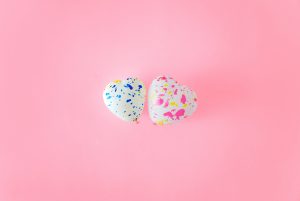Celebrate the science of love with a science party this month!
It’s February, which means there’s only one holiday on our minds this month. Valentine’s Day is the perfect excuse for people to show the love, but why exactly do they feel this way? To answer that question, we wanted to take a look at the science of love – the perfect theme for your February science party!
Many of us will know the feeling – when your cheeks are flushing, your heartbeat is racing and the butterflies in your stomach have taken flight. The biological effects of high emotion might be obvious on the outside, but the science of love actually runs much deeper.
“Love looks not with the eyes, but with the mind, And therefore is winged Cupid painted blind,” wrote Shakespeare in A Midsummer Night’s Dream. Turns out that the Bard wasn’t wrong, as the science of love starts with a unique chemical reaction in the brain.
In terms of biochemistry, research has shown that there are three stages to falling in love, each with their own potent blend of neurochemicals. You’ll see plenty of chemical reactions during our awesome science party, but arguably none of those are as powerful as the ones humans experience when they fall in love. The result is an emotional experience we can’t control.
Science of Love Stage 1: Lust
Stage one is lust – the raw animal attraction governed by oestrogen and testosterone, which increase sexual desire and drive evolutionary theory. Based on a primitive desire to find partner and spread your genes, lust is more of a ‘temporary madness’ than a lasting love and is driven by basic biology.
Photo by Jamie Street
Science of Love Stage 2: Attraction
The second stage behind the science of love – attraction – is far more important to the overall process. This is the ‘love-struck’ phase – that time where you spend hours daydreaming at the rain running down the window pane, doodling their name on your notepad, and sighing deeply while you check your phone for the fiftieth time to see if they’ve messaged you back.
Unsurprisingly, considering the novelty of new love, attraction is driven by the same chemicals that are released during new, exciting experiences. These are adrenaline, dopamine and serotonin – a heady mixture of hormones which cause overpowering infatuation. Together, they make you to act like a lovelorn teenager.
Most of us already know what adrenaline is and have experienced it at some point. Anyone who has watched one of our awesome rocket launches at Sublime Science party will know the feeling!
But even if you’ve never been in love, you’ve probably also experienced a dopamine hit before too. Dopamine is the hormone responsible for the brain’s reward pathways – win a video game? That’s a dose of dopamine. Eat a bag of sweets? That sugar high is actually a dopamine high. Successfully made your own batch of slime at a Sublime Science party? You guessed it, that winning feeling is pure dopamine too.
Serotonin, meanwhile, is more complex. One of the most important chemicals in the science of love, serotonin may actually be responsible for sending us temporarily mad. Attraction leads to a reduction in serotonin – a hormone associated with both appetite and mood. Low levels of serotonin have been associated with anxiety, depression and Obsessive Compulsive Disorder (OCD), meaning that falling in love can result in similar symptoms to that of mental illness. No wonder love can hurt.
Photo by Akshar Dave on Unsplash
Science of Love Stage 3: Attachment
Finally, stage three is long term attachment – a mix of oxytocin and vasopressin, two hormones which encourage bonding. Oxytocin is more commonly known as ‘the love hormone’ as its levels are increased by hugging and physical intimacy. But that intimacy doesn’t necessarily have to be romantic – oxytocin is also the hormone produced after childbirth, powering the bond between mother and baby.
True love can take years, but there is a way you can speed up the science of love. To accelerate the process, try spending time staring into each others eyes. One study found that after an hour of meaningful talk with a stranger, staring into each other’s eyes for four minutes created deep, lasting feelings of attachment. In fact, one couple in the study even went on to get married!
What people might not realise, however, is that the science of love can also determine how long a relationship could last. The higher someone’s levels of dopamine and oxytocin, the longer their relationship is likely to endure. So this Valentine’s Day, show that you care and give that special someone a hug to get those hormones flowing!


